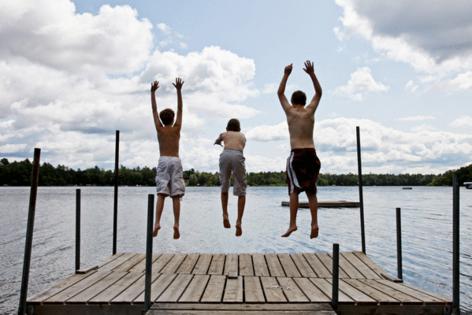Stephen Mihm: Summer camps are returning to their elitist roots
Published in Op Eds
“What are we going to do with the kids this summer?”
More than halfway through July, some iteration of that question continues to be raised in homes across the nation as harried parents scramble to keep their kids occupied in the post-school-year months. Vacation can only go so far. And while some parents may deliberately let their kids “rot” — basically, sit around and get bored — most opt for some version of a time-honored tradition: summer camp.
We live in a world of constant, relentless change, but summer camp is one of those rituals that has survived, largely intact, for over a century. That’s because our conviction that children should have time to “unplug,” make new friends, learn a skill or simply reconnect with nature is nothing new — which is not the same as saying it’s always been that way.
In fact, for much of the nation’s history, most kids spent their summers working in the fields and factories with their parents. Times change, though, and so did ideas about childrearing, ushering in what one historian has described as the “invention of childhood.”
Instead of viewing their offspring as little adults, a growing number of middle- and upper-class moms and dads came to see childhood as a special, vulnerable stage of life — one that called for structured activities that would nurture desired traits.
By the late 19th century, a growing number of these bourgeois parents became anxious about what urban affluence and rapid technological change were doing to their children. They worried, wrote historian Leslie Paris, “that something vital had been lost in the transition: a familiarity with the natural world, a slower pace, a rootedness in the land.”
For some reformers, this nostalgia for an agrarian past informed growing fears that a rising generation of boys, deprived of a connection to nature, would never grow up to become real men.
A Dartmouth College student named Ernest B. Balch was among those who feared the worst. Rowing one fine day on New Hampshire’s Squam Lake, he hit upon an idea: Why not bring boys to the great outdoors and teach them self-reliance? This would address the anxiety that “America was getting soft,” as he later put it.
In 1881, he bought an island on Squam Lake and opened Camp Chocorua, named after a nearby mountain. Kids spent their days hiking, swimming and canoeing. Other like-minded reformers opened their own camps in remote areas, primarily in New England or the Adirondacks.
The early private camps were limited in their influence because they catered to White, affluent Protestant families in the urban northeast. However, that changed with the rise of camps run by national organizations, such as the Boy Scouts and the Young Men’s Christian Association or YMCA. These options, which helped make summer camp more accessible, promoted a “muscular Christianity” that combined religious devotion with a love of nature.
Still, it was all about boys. It wasn’t long before some critics asked: What about girls?
Progressive, college-educated women — proto-feminists — began questioning why boys had a monopoly on summer camp. Why wouldn’t girls need nature, too?
Holt founded what may have been the first summer camp for girls in 1901; a decade later, hundreds of such programs had been established to meet growing demand. A brochure from one of the early ones, Camp Idlewood in the Hudson River Valley, gives us a glimpse of the typical messaging. It declared: “We aim to develop superb womanhood, to give to girls a perfect body, complete symmetrical physical development, a strong physical organism, to make their bodies fitting temples for their souls.”
By the 1930s, somewhere between five and seven thousand camps operated throughout the U.S., hosting an estimated two million campers a year. They catered to different groups – Jews, working-class kids and Catholics. Black children, though, had very few options, save for a handful of segregated private camps in the South and a scattering of options run by the YMCA and YWCA. Integration would only occur well into the postwar era.
Even as they kept out minority groups, many summer programs modeled themselves on an idealized vision of one group of color in particular: Native Americans. For example, Camp Ticonderoga in the Adirondack Mountains assigned campers to one of three “tribes,” but the tone-deaf stereotyping didn’t stop there. Each “Indian Village,” declared the camp’s brochure, “gives the boy the much-needed opportunity to express his inherent savagery. Just to be free, to run, to climb, to shout and yell like a wild Indian on a warpath!”
While these invocations of “primitive” life have disappeared from the summer camp experience, the contours of this annual ritual have changed relatively little over the past century. Last year, the American Camp Association declared that the concept of “unplugging (has) for years been one of our industry’s major selling points to families.”
That may be true, but while some organizations do offer free programs across the country, many camps cost between $300 and $900 per child, per week. So, they’re unaffordable for many families. That’s unfortunate. If anything, the need for summer camp has only grown, as children spend less time outdoors and more time on electronic devices — a trend that researchers believe is undermining children’s mental and physical health.
In many ways, summer camps are right back to where they started: being exclusive, elite, and out of reach for many. If the trend continues, generations of children will lose out on an opportunity to grow, play and belong.
_____
This column reflects the personal views of the author and does not necessarily reflect the opinion of the editorial board or Bloomberg LP and its owners.
Stephen Mihm, a professor of history at the University of Georgia, is coauthor of “Crisis Economics: A Crash Course in the Future of Finance.”
_____
©2025 Bloomberg L.P. Visit bloomberg.com/opinion. Distributed by Tribune Content Agency, LLC.

























































Comments